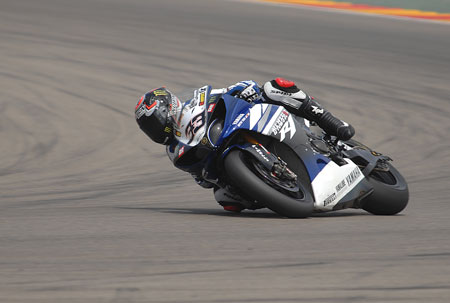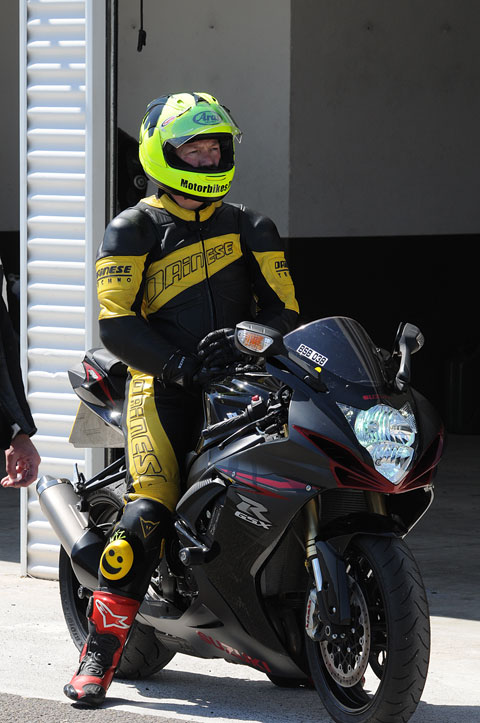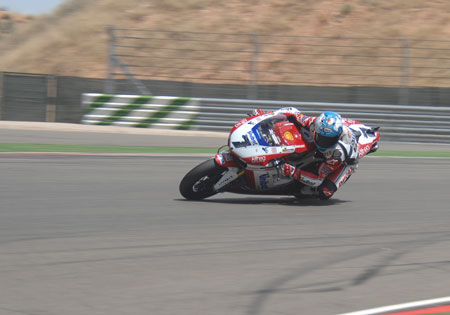 Motorland Aragon,in the North East of Spain, is the newest circuit on the calandar. It
was only completed in 2009 after some spectacular political shenanigans
involving the regional government, Spain's motorsports governing body
and a large number of wealthy local businessmen. This being possibly
the wealthiset area of Spain (though you'd never guess to look at it -
there's not actually a huge amount around, but what there is is either
valuable, old or commercially hugely profitable) that meant a circuit
to rival any in the world. And it really is a great track, with tight,
technical sections, huge elevation changes including a section very
reminiscent of The Corkscrew and a daunting back straight, entered from
a fast downhill run and ending in a first gear hairpin. Oh yes,
Motorland Aragon has it all. The media centre is great, the staff were
friendly and the weather was simply glorious. Which, of course, has its
own issues. But we'll come to that later. Motorland Aragon,in the North East of Spain, is the newest circuit on the calandar. It
was only completed in 2009 after some spectacular political shenanigans
involving the regional government, Spain's motorsports governing body
and a large number of wealthy local businessmen. This being possibly
the wealthiset area of Spain (though you'd never guess to look at it -
there's not actually a huge amount around, but what there is is either
valuable, old or commercially hugely profitable) that meant a circuit
to rival any in the world. And it really is a great track, with tight,
technical sections, huge elevation changes including a section very
reminiscent of The Corkscrew and a daunting back straight, entered from
a fast downhill run and ending in a first gear hairpin. Oh yes,
Motorland Aragon has it all. The media centre is great, the staff were
friendly and the weather was simply glorious. Which, of course, has its
own issues. But we'll come to that later. It was the second qualifying practice that seemed to determine how the rest of the weekend was going to go. It started out with Checa fastest and Biaggi behind; the Aprilia seems to like this circuit as Camier was also in the top ten. Biaggi then took the fastest time and Melandri slotted in second with 22 minutes to go. Badovini started showing he could go and was way up in fourth and Sykes in fifth – making us wonder if this could this be his second pole in a row, as he then went into second with 20 minutes to go. Smrz then set the fastest time followed by Biaggi, leaving ‘golden boy’ Checa now down in fifth, but not for long as he then took the top spot again. Badovini sadly crashed when he was 7th fastest, stopping his chances to qualify higher up in the pack. So with 2 minutes to go the provisional front row was Checa, Smrz, Biaggi and Sykes – but Camier then did a brilliant lap and pushed himself up into fifth...start as you mean to continue, so they say! 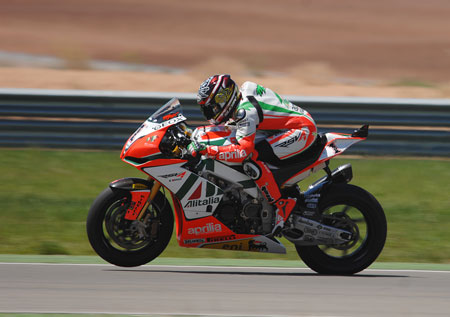 Superpole one,
with 9 minutes to go, had Checa going fastest followed by Camier,
Melandri and Haslam, with Corser falling in fifth and Sykes seventh
behind Laverty. Biaggi’s time then slotted into third with Haga fourth,
pushing Sykes down to eighth. With 4 minutes to go Checa still reigned,
but Camier was now second and Biaggi third. Badovini did a last minute
quick lap and slotted into fourth fastest whilst Checa pulled into the
box and watched, looking very pleased with himself. Guintoli ran off
track and onto the gravel trap but still also third place, with
Fabrizio then setting the fourth fastest time. These late fast times
pushed back some of the top contenders, with surprising consequences as
Corser, Berger, Haslam and Smrz then didn’t qualify for superpole two. Superpole one,
with 9 minutes to go, had Checa going fastest followed by Camier,
Melandri and Haslam, with Corser falling in fifth and Sykes seventh
behind Laverty. Biaggi’s time then slotted into third with Haga fourth,
pushing Sykes down to eighth. With 4 minutes to go Checa still reigned,
but Camier was now second and Biaggi third. Badovini did a last minute
quick lap and slotted into fourth fastest whilst Checa pulled into the
box and watched, looking very pleased with himself. Guintoli ran off
track and onto the gravel trap but still also third place, with
Fabrizio then setting the fourth fastest time. These late fast times
pushed back some of the top contenders, with surprising consequences as
Corser, Berger, Haslam and Smrz then didn’t qualify for superpole two. Superpole two had Biaggi as the top qualifier with 7 minutes to go with Checa in second and Badovini third, soon to be pushed down to fourth by Laverty. Melandri then slotted into fifth, but with 30 seconds remaining, Haga slots up to seventh, pushed down to eighth by Camier doing a fast lap and qualifying fifth. Sykes, however, then pushed Camier to sixth and Haga out of superpole three along with Aitchison, Fabrizio and Guintoli. With 6 minutes remaining in superpole three, Melandri was the fastest with Biaggi behind him and Laverty and Sykes making up the first row. Camier then set an amazing time of 1.58.279, putting him into third place and keeping him there. Checa was fourth and, with three minutes remaining it was still Melandri, Biaggi, Camier and Checa. Sykes was doing a flying lap from qualifying eighth after pitting in but was blocked by another rider, taking valuable time away from his lap. He finally finished in fifth, starting the second row. This left the superpole results and front two rows as Melandri, Biaggi, Camier, Checa, Sykes, Laverty, Lascorz and Badovini. 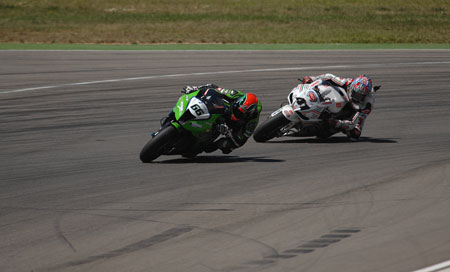 Race time approached fast, and race one
had a good start from Camier, slotting straight into third place
approaching the first corner with Melandri in first and Biaggi in
second. Checa and Haga then overtook Camier, and Biaggi overtook
Melandri after a short battle for first. Camier then returned Haga’s
favour and took fourth place back, leaving the first four after the
first lap as Biaggi, Melandri, Checa and Camier. Race time approached fast, and race one
had a good start from Camier, slotting straight into third place
approaching the first corner with Melandri in first and Biaggi in
second. Checa and Haga then overtook Camier, and Biaggi overtook
Melandri after a short battle for first. Camier then returned Haga’s
favour and took fourth place back, leaving the first four after the
first lap as Biaggi, Melandri, Checa and Camier. A pack of bikes and lots of overtaking left something being knocked off someone’s bike (vague I know but it was a little difficult to tell exactly what happened) and Camier overtook Checa into third place by going around the outside and blocking him off, leaving him in the capable hands of Haga. At this stage, the top ten riders were still incredibly close, but Biaggi started to make a small gap with Melandri hot on his tail. It all ended for Lanzi on the third lap, as he had to enter the pits due to a technical problem but Sykes had started working his way up the pack and was now sat in sixth place. Further down the field, Vermeulen showed signs of improvement as his times started to decrease leaving him eighteenth, just a few more places and he’d be getting points. Vermeulen’s a prime example of how much a seemingly minor crash can make a rider have to start from square one again. Camier and Checa fought for third and Checa got it, Camier trying to take it back on the inside but being blocked off. Camier did briefly overtake again going into the next corner, but into the straight Checa got straight back in front. Remember that, whilst riders battle for places it increases their lap time, so this gave Biaggi and Melandri the chance to pull away and Checa and Camier less hope for any more than third. Checa now had a small gap ahead of Camier, with Sykes chasing Haga to try and get fifth. The heat wasn’t a help to any of the riders, as when the tarmac gets too hot it melts the tyres and gives them less grip, making it harder to gain speed and overtake without overdoing it and falling off. Speaking of falling off, Smrz then did so on turn one, getting up and walking away. Melandri, in the mean time, caught up to Biaggi and was gearing himself up to overtake. 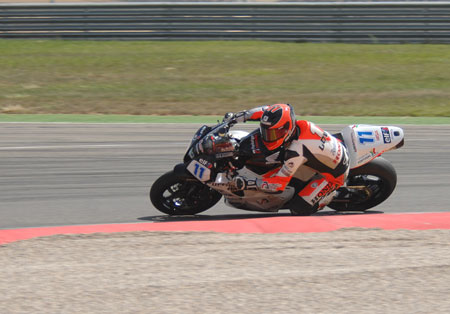 Lap seven saw Xaus run onto the gravel at turn one, rejoining in
seventeenth place beforeo having to enter the pits due to the problems
the gravel caused. There was a big gap forming between Checa and
Camier, as Checa had started to push in an attempt to catch up with
Melandri and Biaggi. Maybe he ushed a little too hard, though, as he,
Checa then crashed on lap eight at turn ten, he was OK but
understandably rather annoyed, but did put British boy Leon Camier on
the podium, as long as he stayed steady. Fabrizio then crashed on lap
ten, losing his eighth place finish after climbing up the pack – he
also sent his bike straight into the wall, which would have been
expensive. Sykes finally overtook Haga on lap eleven, leaving the
standings as Biaggi, Melandri, Camier and Sykes. Haslam and Corser
showed some team-mate action as they then started to battle for tenth,
with Haslam managing to keep it. Lap seven saw Xaus run onto the gravel at turn one, rejoining in
seventeenth place beforeo having to enter the pits due to the problems
the gravel caused. There was a big gap forming between Checa and
Camier, as Checa had started to push in an attempt to catch up with
Melandri and Biaggi. Maybe he ushed a little too hard, though, as he,
Checa then crashed on lap eight at turn ten, he was OK but
understandably rather annoyed, but did put British boy Leon Camier on
the podium, as long as he stayed steady. Fabrizio then crashed on lap
ten, losing his eighth place finish after climbing up the pack – he
also sent his bike straight into the wall, which would have been
expensive. Sykes finally overtook Haga on lap eleven, leaving the
standings as Biaggi, Melandri, Camier and Sykes. Haslam and Corser
showed some team-mate action as they then started to battle for tenth,
with Haslam managing to keep it. Sykes’ good fortune started to wane as Haga then overtook him again in lap fourteen, followed by Laverty on lap fifteen, then Lascorz on lap sixteen, leading us to believe he was struggling. Meanwhile, also on lap sixteen, Biaggi ran slightly wide, allowing Melandri to dive straight through and into first place. As mentioned before, this battling slowed them down, and Camier started gaining on the top two very rapidly, closing the gap to only two seconds. Laverty then overtook Haga into fourth and Corser overtook Haga to take ninth place. Sykes also seemed to regroup and overtook Lascorz again. Camier’s laps were getting faster and faster, and it was clear that, if there were just a few more laps, he could have easily taken first place. Haslam also overtook Corser again, pushing him down to tenth place. On the last lap Sykes overtook Haga again, and Melandri won the race with Biaggi in second and Camier third. Laverty finished in fourth followed by Sykes, Haga, Lascorz, Haslam and Corser – but it was a very close finish between Laverty and Sykes. Between Superbike races, Chaz Davies put the Union Flag at the top with a tidy and well earned win in the Supersport race, while Sam Lowes rode the wheels off the slightly outgunned Parkalgar Honda to take second, ahead of local hero David Salom. Pretty good considering that both Yamaha and Kawasaki (first and third) nominated Aragon as their official test track and their bikes had a good five km/h advantage through the speed trap. Honourable mention to Gino Rea as well, on the massively outclassed Step Honda, taking a hard fought sixth place. 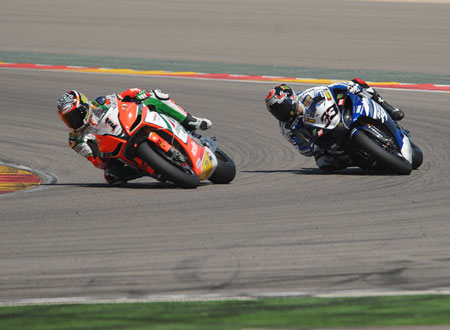 Back to Superbikes, then.
Race two
saw another good start from Camier, but Biaggi took the lead with
Melandri behind him and Camier, once again, in third just to be
overtaken straight away by Sykes. Lascorz then also overtook Camier,
leading to a battle between them which Lascorz came out top of. Maxime
Berger t-boned Corser at the end of the long fast back straight,
knocking them both off. Berger walked away but Corser was left with a
broken radius and ulna in his left arm. This left the standings by the
end of lap two as Biaggi, Melandri and Sykes. Fabrizio and Checa then
both overtook Camier on lap three, but it was, once again, the Biaggi
and Melandri show for the top two. Fabrizio and Checa then went on to
overtake Lascorz, whilst Haga overtook Haslam into eighth place. Back to Superbikes, then.
Race two
saw another good start from Camier, but Biaggi took the lead with
Melandri behind him and Camier, once again, in third just to be
overtaken straight away by Sykes. Lascorz then also overtook Camier,
leading to a battle between them which Lascorz came out top of. Maxime
Berger t-boned Corser at the end of the long fast back straight,
knocking them both off. Berger walked away but Corser was left with a
broken radius and ulna in his left arm. This left the standings by the
end of lap two as Biaggi, Melandri and Sykes. Fabrizio and Checa then
both overtook Camier on lap three, but it was, once again, the Biaggi
and Melandri show for the top two. Fabrizio and Checa then went on to
overtake Lascorz, whilst Haga overtook Haslam into eighth place. The weekend ended badly for Smrz, as he ended up with two DNFs after crashing on lap five at turn fourteen, with Haslam falling behind when overtaken by Laverty. Checa and Fabrizio kept on overtaking, as they both got past Sykes, putting Fabrizio into third place. However, there was already a three second gap between Melandri and Checa, with Melandri still very close to Biaggi. Xaus had to retire from the race and enter the pits on lap seven (another technical problem) and, sadly, Sykes crashed on this lap with a fast low side. Fortunately the Yorkshireman was unhurt. Camier also dropped back into eighth place as Haga overtook him, but was still setting quicker lap times. Haslam’s weekend seemed to get worse as Badovini then overtook him, but things suddenly stopped happening and people stopped overtaking! Haslam overtook Badovini again on lap thirteen, but tenth place was a whole 18 seconds behind Biaggi’s first place. Melandri stayed very close to Biaggi, hoping for a double, but on lap sixteen he lost the front end and though he managed to save it he ranning off track and ended up with a 5 second gap behind Biaggi. At this point we knew the most likely result, as did Melandri because he seemed to relax a bit. Laverty overtook Haga on lap nineteen, and by the final lap there were 20 seconds between first and eighth place – which is a huge difference! Biaggi finished the race way in the lead, cruising over the line with a quick glance over his shoulder. Melandri finished second, Checa third and then Fabrizio, Lascorz, Laverty, Haga, Camier, Haslam and Badovini. Brno next and, as usual, we’ll be there – but unfortunately Johnny Rea still hasn’t recovered fully enough to race, so will be missing his favourite circuit’s round. We’ll keep you posted on Corser.
1 Marco Melandri (Yamaha)
2 Max Biaggi (Aprilia) 3 Leon Camier (Aprilia) 4 Eugene Laverty (Yamaha) 5 Tom Sykes (Kawasaki) 6 Noriuki Haga (Aprilia) 7 Joan Lascorz (Kawasaki) 8 Ayrton Badovini (BMW) 9 Leon Haslam (BMW) 10 Troy Corser (BMW) Race Two
1 Max Biaggi (Aprilia)
2 Marco Melandri (Yamaha) 3 Carlos Checa (Ducati) 4 Michel Fabrizio (Suzuki) 5 Joan Lascorz (Kawasaki) 6 Eugene Laverty (Yamaha) 7 Noriuki Haga (Aprilia) 8 Leon Camier (Aprilia) 9 Leon Haslam (BMW) 10 Ayrton Badovini (BMW)
Championship Standing
after seven rounds:
1 Carlos Checa 261
2 Max Biaggi 218 3 Marco Melandri 195 4 Eugene Laverty 146 5 Leon Camier 125 6 Leon Haslam 120 7 Michel Fabrizio 108 8 Jonathan Rea 94 9 Noriuki Haga 89 10 Ayrton Badovini 86
LB
| |
SBK Aragon
Friday 28 September 2012
Labels:
SBK.
Suzuki GSX-R 750L1
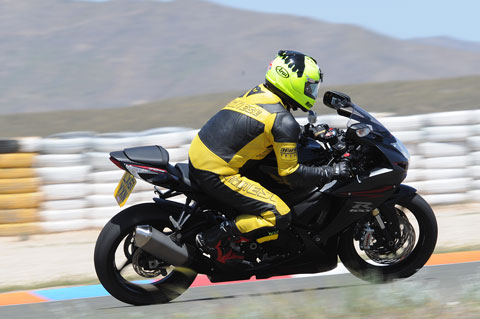 Suzuki
have a slogan that always accompanies their current GSX-R adverts. That
slogan is "Own the Racetrack." Now we're cynics, and frankly Suzuki
haven't done all that well at owning the tracks in recent years. So
perhaps the GSX-R 750, that loan voice crying out in a class devoid of
any race series, is all mouth and trousers. Only one way to find out... Suzuki
have a slogan that always accompanies their current GSX-R adverts. That
slogan is "Own the Racetrack." Now we're cynics, and frankly Suzuki
haven't done all that well at owning the tracks in recent years. So
perhaps the GSX-R 750, that loan voice crying out in a class devoid of
any race series, is all mouth and trousers. Only one way to find out...
Almeria in Southern Spain is a lovely privately owned test circuit. Just about the perfect place to take a bike like this. Strights long enough to stretch its legs and enough corners to really try handling as well. Now for reasons documented elsewhere, this particular GSX-R has only done six hundred miles. Well, it had when it got to Spain, anyway. So straight after its first service it went on a trackday, which might be a little unfair on it. the gearbox was still a bit tight and I did my best to stick to the rev limit imposed on the still new engine, though I have to admit that it may have got stretched a little. But I'm getting ahead of myself. As usual. We've looked at the bike itself already here, so there's not much more to say about it. As part of my standard fettling I'd already removed the stock steering damper and replaced it with a GPR rotary damper (reviewed here) but other than that track preparation consisted of folding the mirrors in and dropping the tyre pressures after the first session. Personally I run the tyres at thirty six PSI at each end when hot, which seems to work quite well. Despite what many magazines will tell you, I left the suspension on stock settings front and rear. Unless you're a top flight racer (and I'm not any more) then in truth you're unlikely to push hard enough to warrant any serious fiddling. So. I was new to Almeria and having endured a lengthy layoff from riding was feeling distinctly rusty. The five lap guided tour at the beginning was extremely useful, and by the end I was able to go quickly enough to at least get some decent heat in the tyres. Cue a quick visit to the pits to adjust pressures and have a quick check over. Nothing leaking or looking strained, and my initial notes say that the OE tyres felt fine from the off, though much better when the pressures had been reduced and that the gearbox, especially changing from fourth to fifth on the back straight, was a little stiff and balky. In fairness I think that was as much me as the box, and either way the problem went away as the test progressed. 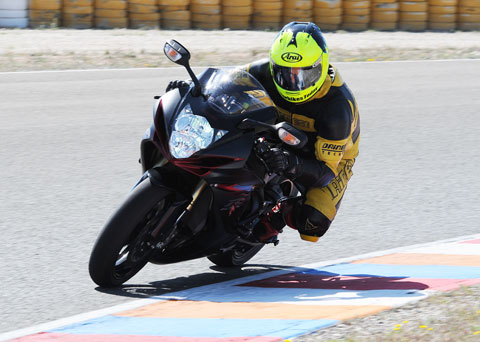 Getting
on with things, mirrors folded in and a swift half a dozen laps with an
instructor to hasten my learning the best lines around the quite
technical track saw the Suzuki starting to come into its own. Almeria
is almost two distinct tracks. There's a long straight with a tight
chicane in the middle of it and long sweeping bends at each end. And
there's the back section where the bike is hardly ever going in a
straight line and is frequently cranked right over. So let's take a
lap, shall we? Getting
on with things, mirrors folded in and a swift half a dozen laps with an
instructor to hasten my learning the best lines around the quite
technical track saw the Suzuki starting to come into its own. Almeria
is almost two distinct tracks. There's a long straight with a tight
chicane in the middle of it and long sweeping bends at each end. And
there's the back section where the bike is hardly ever going in a
straight line and is frequently cranked right over. So let's take a
lap, shall we? We cross the start/finish line at around a hundred and twenty and immediately drop slightly downhill, passing the pitlane exit about fifty metres later. Hard over to the left, braking smoothly and peeling into a long right hander that climbs toward the exit. The bike is completely stable and transitions smoothly from braking to turning. Keep over to the left exiting the corner and accelerate, leaving my body over to the right in preparation for the track dropping down and right. Turn in very lateand make a wide arc. Again the bike is stable and shows no sign of pushing the front. It doesn't mind accelerating while I'm still partly hanging off either. Next comes a left hander that goes on forever. There seem to be lots of lines around here. I tend to go in deep and then make a constant radius, apexing very late and almost immediately flicking right for the next corner as we climb back uphill again. Utterly stable and plenty of grip, though later in the day when it was very hot this was one place I felt the back starting to move around. The next right climbs and then drops away and the latter part is blind. It's also easy to lose the front as you're still cranked over when you go over the crest of the rise. Braking, chopping the throttle and even going offline to make a sneaky pass failed to disrupt things at all. Next is a sharp left which is followed by a twenty metre or so straight and an open chicane. The left of this chicane has a dip in the middle, and this caused me my only real problem as I lost a toe slider going through there, much to my annoyance. The bike was fine, though it could be provoked into a bit of a slide if I really pushed it. A long gentle left, again over a rise, leads into a very sharp chicane which in turn leads straight into a long right hander. The chicane can be straightlined. The GSX-R doesn't mind if you ride the kerbs and I didn't experience any pad knock afterwards. Exiting the long right it's a case of accelerating as hard and as early as possible. Up against a couple of other GSX-Rs from different generations I was able to show that the current bike just has the edge here, but there's really not much in it. 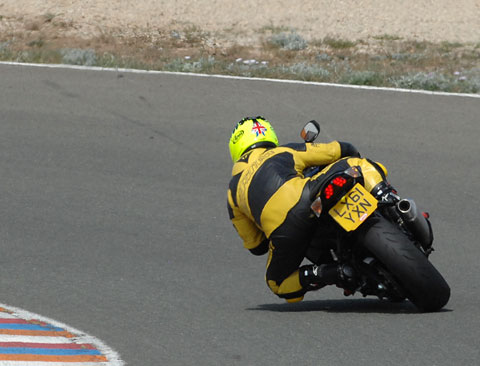 Now
we have a half mile or so of straight. Slightly uphill, good drive out
of the last corner can see the GSX-R hitting an indicated hundred and
fifty miles per hour before hitting the brakes for a really sharp and
rather unforgiving chicane which leads onto the start finish straight
to do it all again. The end of the straight is one of the safest places
to pass riders on faster bikes who may not be so good in corners, but
it requires good brakes and a well poised chassis, because apart from
anyting else there's a good chance of being in the wrong place on the
track at this stage. Happily the GSX-R fits the bill. The brakes are
excellent, being easily able to elevate the back wheel at stupid speeds
should you so wish but blessed with sufficient feel as to make that
unlikely if you don't want it to happen. Certainly they inspire
confidence, which sets up well for the next lap. Now
we have a half mile or so of straight. Slightly uphill, good drive out
of the last corner can see the GSX-R hitting an indicated hundred and
fifty miles per hour before hitting the brakes for a really sharp and
rather unforgiving chicane which leads onto the start finish straight
to do it all again. The end of the straight is one of the safest places
to pass riders on faster bikes who may not be so good in corners, but
it requires good brakes and a well poised chassis, because apart from
anyting else there's a good chance of being in the wrong place on the
track at this stage. Happily the GSX-R fits the bill. The brakes are
excellent, being easily able to elevate the back wheel at stupid speeds
should you so wish but blessed with sufficient feel as to make that
unlikely if you don't want it to happen. Certainly they inspire
confidence, which sets up well for the next lap. After over two hundred and fifty miles on track over two days I can confidently report that the current GSX-R 750 is an outstandingly capable track bike straight out of the box. The adjustable steering damper I'd fitted was entirely surplus to requirements. Even when the front did come up under hard acceleration it remained completely under control and didn't even need me to back off the throttle. The standard equipment Bridgestone BT016 tyres were unreasonably good, offering bags of grip and plenty of warning before even feeling as though they might let go. Astonishingly, though clearly well used they were still legal and perfectly acceptable for road use after this abuse. I reckon there's another couple of thousand road miles on 'em yet. There's plenty of power from the revvy, responsive engine, with more to come as the miles go on it I think. Throttle response is outstanding and there's no driveline shunt or any other nastiness to upset things. The brakes, as I've mentioned before, are sublime, and the suspension, especially the Big Piston Forks, is little short of a revelation. The levels of ride control from stock units would have been unheard of a few years ago. If I had to change anything, I'd make it easier to remove road fripperies like mirrors and number plate and I'd fit a quickshifter. There's a laptimer fitted as standard but I never touched it. So in short I am very happy to confirm that yes, if you have a current Suzuki GSX-R 750 then you can indeed Own the Racetrack. I'm sure you probably can with just about any other sportsbike as well, but the 750 remains, to me, the perfect combination of power and agility. If I had to choose a bike to ride in anger then this would be it, every time.
SB
| |
Labels:
Suzuki
2012 Aprilia Shiver 750
Thursday 20 September 2012
2012 Aprilia Shiver 750 present with style and technology content is so fresh, creating a fun and innovative ergonomic design, sporty and aggressive so as to attract the hearts of consumers in the world.
2012 Aprilia Shiver equipped V90 engine with high-performance mechanics feature twin-cylinder engine, capable of combining a very high level of output with maximum exploitation rates, user-friendly riding options, great torque throughout the RPM, minimal vibration, and superb output produces maximum power of 95 HP at 9,000 rpm and maximum torque of 81 Nm at 7,000 rpm.
Upside-down fork with 43-mm stanchions and shell cast calliper offers standard 120-mm smooth way to tackle city streets and mountain roads as well as the dynamic qualities by 5.5 x 17 rear wheel, which maximizes dexterity and speed changes of direction.
For 2012 Aprilia Shiver security features include 750 rear brake is equipped with a 245mm disc single piston calliper to provide full support to the front system. In addition to adopting the ABS version 2-channel Continental system which is able to ensure maximum levels of safety when braking in all conditions.
2012 Aprilia Shiver 750 Specs and Review
The main characteristics of the Aprilia Shiver 750 are:- V2 90° engine with four valves per cylinder, double overhead camshaft and liquid cooling;
- the integral Ride-by-Wire tri-map technology developed for competitions;
- modular trellis/aluminium frame with significant torsional rigidity;
- aluminium swingarm with stiffener brace and lateral shock absorber;
- 43 mm upside down fork;
- racing brakes with radial callipers and 320mm Wave discs
- Sport rider/passenger footpegs
- Rear wheel with 5.5 mm channel
With a simple twist of the control the rider can move even with the throttle closed to radically change the character of motorcycle:
- “Sport” to have the “throttle in hand” when a rider needs to let off steam exploiting the entire character of this Italian twin cylinder bike;
- “Touring” when smoother power delivery and fluidity are essential during the moments when the racing desires are set aside to enjoy a more relaxing ride, even two-up;
- “Rain” when grip is not as good as it should be and maximum safety is the main objective.
2012 Aprilia Shiver 750 Specs :
Engine type
Aprilia V90 Longitudinal two cylinder 90° V, 4 stroke, liquid cooled, double overhead shaft timing controlled by a mixed gear/chain system, four valves per cylinder.
Fuel Unleaded Petrol
Bore and stroke 92 x 56.4 mm
Total engine capacity 749.9 cc
Compression ratio 11: 1
Max power at the shaft 95 HP at 9,000 rpm
Max torque at the shaft 8.25 kgm at 7,000 rpm
Fuel system Ride by Wire integrated engine control system.
Ignition Digital electronic ignition integrated with injection system.
Starter Electric
Exhaust 2 in 1 system made entirely of stainless steel with three way catalytic converter and lambda probe
Alternator 450 W at 6,000 rpm
Lubrication Wet sump
Gearbox 6 speeds, drive ratio:
1st 36/14 (2.57)
2nd 32/17 (1.88)
3rd 30/20 (1.5)
4th 28/22 (1.27)
5th 26/23 (1.13)
6th 25/24 (1.04)
Clutch Multiple discs in oil bath with hydraulic control
Primary drive Straight cut gears, drive ratio: 60/31 (1.75)
Secondary drive Chain. Gear ratio: 16/44
Chassis Modular steel trellis connected with high resistance bolts to aluminium side plates. Modular rear frame.
Front suspension Upside down fork with 43 stanchions. 120 mm wheel travel.
Rear suspension Aluminium alloy swingarm with stiffener brace.
Hydraulic shock absorber with adjustable rebound and preload. 130 mm wheel travel.
Brakes
Front: Dual 320 mm diam. wave stainless steel floating disc. Radial callipers with four pistons.
Metal braided brake pipe.
2-channel Continental ABS system
Rear: 240 mm stainless steel wave disc. Single piston calliper. Metal braided brake pipe.
Wheel rims Aluminium alloy
Front: 3.50 X 17″ Rear: 5.5 x 17″
Tyres Tubeless radial;
front: 120/70 ZR 17
rear: 180/55 ZR 17
Dimensions
Max. length 2,265 mm
Max. width 810 mm (at handlebar)
Max. height 1,135 mm (at instrument panel)
Saddle height 800 mm
Centre to centre distance 1,440 mm
Trail 109 mm
Steering angle 25.7°
Tank 15 lt
Labels:
Aprilia
2013 Aprilia Caponord 1200
2013 Aprilia Caponod 1200 will be launched with a new design equipped with triple map ride-by-wire with the concept of sport, touring and a special mode when it rains. While technology brings ultralight modular frame made from a combination of steel trellis with aluminum casting.
This bike looks dashing and soul pelualangan. 2013 Aprilia CapoNord 1200 using a base of Dorsoduro. Base used this bike is the frame, wheels, steel up suspense, but wrapped with a different face. With electronic suspension or “Electronic Dynamic dampening” make this bike incredible versatile, electrically adjustable Ohlins suspension on the S version ($ 19,995). There are no speed-sensor rotor ring seen in the Brembo brakes.
2013 Aprilia Caponord 1200 Price and Review
2013 Aprilia Caponod 1200 using engine capacity 1197 cc power 130 hp capable of achieving at 8700 rpm and torque of 85ft-lb at 2700 rpm. The machine carries konvigurasi v-twin is already DOHC with four valves and two spark plugs in each cylinder.2013 Aprilia Caponod 1200 has a design that is right beside the exhaust and rear lights form a more modern. For braking devices, 2013 Aprilia CapoNord 1200 equipped with 320 mm brake discs, making the process smoother and more braking mengcengkram. In addition to 320 mm brake discs, there are also 17-inch alloy wheels with diameters that make unique and artistic zoom.
Labels:
Aprilia
Aprilia Sportcity 125
2012 Aprilia Sportcity 125 is a
beautiful scooter designed with a very dynamic posture and combined
with the latest technology. Aprilia Sportcity 125 is the answer for
those who want practicality, agility pengandaraan style that is sporty
and comfortable. There are two separate headlamps designed and
different functions. Functioned as the right side near the lamp or low
beam while the left side functioned as a beam or high beam. While the
two twilight lamps positioned at each corner of the two lights earlier.
2012 Aprilia Sportcity 125
2012 Aprilia Sportcity 125 is designed
for urban mobility with best-in-class technology. This scooter is
designed with a sporty and dynamic look of the body lines and bold body
is angled end. Style is the strongest point of the scooter Aprilia
Sportcity 125 cc engine. Just from looking at her, the pleasure of
driving a Sportcity 125 is very pronounced.
2012 Aprilia Sportcity 125 reinforced with a machine that has a
capacity of 124 cc single cylinder 4 stroke, comes with a Liquid cooled
horizontal centrifugal pump with 4 valves. With the engine compression
12.5: 1, the Sportcity 125 is claimed to achieve maximum torque by 11
Nm at 8,250 rpm. 2012 Aprilia Sportcity 125 is also equipped with
hydraulic suspension 35 mm to provide driving comfort is good even
though the street was broken. While the ban is applied measuring 15
inch, 120/70 tires for the front and 130/80 for the rear tires.
2012 Aprilia Sportcity 125 White
2012 Aprilia Sportcity 125 Silver
For 2012 Aprilia Sportcity security features 125 equipped with disc
brakes measuring 260 mm with two-piston caliper to provide confidence
when braking for the safety of motorists. While on the cockpit
instrument panel as there are two pointer speed and fuel conditions in
the tank, making the 2012 Aprilia Sportcity 125 look more dynamic.2012 Aprilia Sportcity 125
Price : MSRP $2,899| Manufacturer | Aprilia |
| Year | 2012 |
| Model | SportCity 125 |
| Category | Scooter |
| Price | 2799.00 |
| Engine type | 4-stroke |
| Cylinder | 1 |
| Valvetrain | SOHC, 2 valves per cylinder |
| Cooling system | Forced-Air |
| Displacement (cc) | 125.0 |
| Ignition | Electronic |
| Starter | Electric |
| Gearbox operation | CVT Automatic |
| Final drive | Belt |
| Front suspension type | 32-mm hydraulic telescopic fork |
| Front suspension travel (mm) | 85 |
| Rear suspension type | Swingarm, dual shocks, adjustable preload |
| Rear suspension travel (mm) | 84 |
| Front brakes | 220-mm discs with 2 pistons calipers |
| Rear brakes | 140-mm drum |
| Front tire - Width |
120 |
| - Profile | 70 |
| - Wheel diameter | 14 |
| Rear tire - Width |
120 |
| - Profile | 70 |
| - Wheel diameter | 14 |
| Length (mm) | 1950 |
| Width (mm) | 740 |
| Weelbase (mm) | 1358 |
| Seat height (mm) | 776 |
| Weight (kg) | 117 |
| Fuel capacity (L) | 7.5 |
| Colour(s) | Aprilia Black, Wave Blue, Cult White |
Labels:
Aprilia
Kawasaki KX250F
2013 Kawasaki KX250F is Kawasaki KX motocross series that was
modified on the suspension. Motorcycle “off-road” uses of the Showa
suspension but changes to a more progressive damping and uses a larger
48mm tube.
There was also conducted on the
cylinder head design for increased air flow better in Airbox, dual
injector and a more compact frame. KX 250F gets a new exhaust 30mm
shorter. This makes the exhaust much closer to the center of the engine
with the exhaust chamber 7mm wider, yet still meet the requirements of
94 dB.
Kawasaki KX250F uses aluminum perimeter
chassis to increase the overall stiffness. Lengthening the front with a
20mm aluminum swingarm offers 4.2% increase in stiffness. In addition
it offers the right fork preload adjustment for the perfect ride.
Internally the main piston (rebound) and the sub piston (compression)
is larger and comes from an increase in the lower fork tubes from 47mm
to 48mm.
Kawasaki KX250F Engine
In addition to the design of a powerful
engine and better handling, Kawasaki KX250F also has a beautiful view.
By converting the plastic into the fender, slender body, suspension
adjuster, spark plugs are blue anodized engine, clutch and ignition
side cover is no longer black, fresh appearance will continue to be
updated from time to time.
2013 Kawasaki KX250F
Engine: DOHC, 4-valve, Liquid-cooled, 4-stroke Single
Displacement: 249cc
Bore x Stroke: 77.0 x 53.6mm
Fueling: DFI® with 43mm Keihin throttle body and dual injectors
Compression Ratio: 13.8:1
Transmission: Five-speed with wet multi-disc manual clutch
Final Drive: Chain
Frame: Aluminum perimeter
Rake/Trail: 28.7 deg. / 5.0 in.
Front Suspension: 48mm Showa SFF fork, 40-way spring preload adjustability, 22-position compression, 20-position rebound damping, 12.4 in. travel
Rear Suspension: Uni-Trak® linkage system and Showa shock, 9-position low-speed and stepless high-speed compression, 22-position rebound damping, adjustable preload, 12.2 in. travel
Front Tire: 80/100-21
Rear Tire: 100/90-19
Front Brake: Semi-floating 250mm petal disc, 2-piston caliper
Rear Brake: 240mm petal disc, 1-piston caliper
Overall Length: 85.4 in.
Overall Width: 32.3 in.
Overall Height: 50.0 in.
Wheelbase: 58.1 in.
Ground Clearance: 13.0 in.
Seat Height: 37.2 in.
Curb Weight: 233.6 lbs. (claimed)
Fuel Capacity: 1.61 gal.
Color: Lime Green
Displacement: 249cc
Bore x Stroke: 77.0 x 53.6mm
Fueling: DFI® with 43mm Keihin throttle body and dual injectors
Compression Ratio: 13.8:1
Transmission: Five-speed with wet multi-disc manual clutch
Final Drive: Chain
Frame: Aluminum perimeter
Rake/Trail: 28.7 deg. / 5.0 in.
Front Suspension: 48mm Showa SFF fork, 40-way spring preload adjustability, 22-position compression, 20-position rebound damping, 12.4 in. travel
Rear Suspension: Uni-Trak® linkage system and Showa shock, 9-position low-speed and stepless high-speed compression, 22-position rebound damping, adjustable preload, 12.2 in. travel
Front Tire: 80/100-21
Rear Tire: 100/90-19
Front Brake: Semi-floating 250mm petal disc, 2-piston caliper
Rear Brake: 240mm petal disc, 1-piston caliper
Overall Length: 85.4 in.
Overall Width: 32.3 in.
Overall Height: 50.0 in.
Wheelbase: 58.1 in.
Ground Clearance: 13.0 in.
Seat Height: 37.2 in.
Curb Weight: 233.6 lbs. (claimed)
Fuel Capacity: 1.61 gal.
Color: Lime Green
Labels:
Kawasaki
2012 Kawasaki Ninja 250R
2012 Kawasaki Ninja 250R has all the
essential elements that make it perfect sportbike, like the smooth
torque delivery at lower speeds, low seats and powered by a
liquid-cooled, twin cylinder.
With an aggressive style and modern
aerodynamic fairing supersport bodywork fitted windscreen makes the
Kawasaki Ninja 250R looks great and gives a deflection of wind to be
effective in a variety of conditions that increase your driving
pleasure and comfort.
2012 Kawasaki Ninja 250R is equipped
with 249cc DOHC parallel twin-cylinder engine that offers mass
centralization and handling superior to the mid-range and high-rpm for
excellent performance on the highway. Equipped also tasked with keeping
the weight of the ring piston to help prevent oil consumption and Twin
Keihin carburetor CVK30 that offer better power and helps fuel economy.
On the cylinder head combustion chamber is designed to maximize
combustion efficiency and reduce emissions such as intake and exhaust
ports contribute to good off-idle response and smooth power delivery,
Valve is designed to manage time or a strong low and mid-range torque,
direct valve actuation helps ensure high-rpm operability.2012 Kawasaki Ninja 250R
Engine: Four-stroke, liquid-cooled, DOHC, parallel twinDisplacement: 249cc
Bore x stroke: 62.0 x 41.2mm
Compression ratio: 11.6:1
Cooling: Liquid
Carburetion: Keihin CVK30 x 2
Ignition: TCBI with digital advance
Transmission: Six-speed
Final drive: O-ring chain
Frame: Semi-double cradle, high-tensile steel
Wheelbase: 55.1 in.
Rake / trail: 26 degrees / 3.2 in.
Front suspension / wheel travel: 37mm hydraulic telescopic fork / 4.7 in.
Rear suspension / wheel travel: Bottom-link Uni-Trak® with 5-way adjustable preload / 5.1 in.
Front tire: 110/70-17
Rear tire: 130/70-17
Front brake: Single 290mm hydraulic petal disc with two-piston caliper
Rear brake: Single 220mm petal disc with two-piston caliper
Overall length: 82.1 in.
Overall width: 28.1 in.
Overall height: 43.7 in.
Seat height: 30.5 in.
Curb weight: 374.9 lbs.
Fuel capacity: 4.8 gal.
Color choices / special edition: Candy Lime Green, Metallic Spark Black, Passion Red/Metallic
Spark Black
Warranty: 12 months
Optional Good Times™ Protection Plan 12, 24, 36 or 48 months
Labels:
Kawasaki
CFMoto 650 NK
Sunday 9 September 2012

We say: “Comparable quality for less cash.”
The Chinese-made CFMoto 650 NK can’t help but remind you of the Japanese invasion of the 1960s. Just as Honda’s game-changing CB450 was the first Japanese motorcycle Western customers saw as fun as well as functional, sporty in addition to affordable, the naked NK appears to be the first “real” bike to emanate from the world’s largest motorcycle market that is the People’s Republic of China.
Powered by a parallel-twin, 649cc engine that matches Kawasaki’s ER-6n in almost every respect—there’s little denying that this is a knock-off of a proven Japanese design—the NK is still the first motorcycle to come out of China with an engine larger than 250cc. And after riding the NK, I’m convinced that it’s worthy competition for any budget or beginner’s bike from Asia or Europe, and available at a significantly lower price. In Australia, the 650 NK will sell for just more than half as much as its Kawasaki competitor.
CFMoto’s parent company, Chunfeng Holding Group, was founded in 1989 but didn’t start making complete motorcycles until 2000. Development of the 650 NK began in 2009 and the bike was launched in Asia early in 2011. Pending EPA homologation, shipments of China’s first middleweight motorcycle will begin steaming for America.
Because the bike hadn’t passed Australian homologation yet, my test ride took place on the Broadford circuit in Victoria. I admit I approached the CFMoto armed with every possible prejudice against Chinese-made motorcycles, all born from hands-on experience riding various poorly made 250cc singles.

CFMoto’s
parallel twin is slated to appear in a fully-faired touring bike as
well as a dual sport. Expect CFMoto dealers to start appearing later
this year.
So from the first moment I first saw the CFMoto 650
NK, I was ticking mental boxes. Styling: hmm, not bad, in fact pretty
sharp with its stubby R6-type exhaust, bright red frame and black
bodywork that’s so reminiscent of the ER-6n. The paint depth and
overall finish look equal to any Japanese-made budget bike, though the
plastic switchgear still seems a little low-rent, and unpolished
aluminum brake and clutch levers look rather drab.
The transmission clicked precisely into gear and during some 45 laps of the Broadford circuit I never missed a single shift. For what’s sure to be a very inexpensive bike, the 650 NK works better than it should. The parallel-twin engine is torquey, free-revving and smooth. Acceleration is determined rather than assertive, but it’s sufficiently strong to be satisfying, and the torque peak is spread widely enough that there’s no point in revving it anywhere near redline. The motor pulls from 3000 rpm upwards, with power building all the way to the rev limiter at 10,800 rpm.

The
view from the cockpit of China’s first full-sized motorcycle is
minimalist. The LCD display shows speed, engine temp and other
pertinent ride data.
With Kayaba’s Chinese affiliate providing the 41mm
telescopic forks and centrally mounted shock (not offset, as on the
ER-6n and Ninja 650), the 650 NK’s suspension compliance was frankly
much better than I expected, with good ride quality and the ability to
absorb bumps and ripples in the road surface without affecting the
steering. And the way the bike steers is indeed excellent, delivering
poise plus stability and allowing me to pick lines that would avoid the
oil patches left by the previous weekend’s vintage bike races. Equipped
with Cheng Shin tires labeled simply “Radial,” I was quite cautious
entering corners on the NK. The tires stuck, though, and as I added
speed and lean angle, the long hero tabs began dragging and soon I was
using the toe sliders on my Kushitani boots.
Which leaves just one key aspect I couldn’t answer in my one-day Broadford bash—how well will the 650 NK wear the passage of time and miles? It’s impossible to guess after even a thorough test ride, but if it’s as well manufactured as it has been engineered, then this bike may have the same impact on the marketplace as the Honda CB450 did 47 years ago, becoming the bike that introduces Chinese motorcycles to the Western world. The NK could well be a game changer.
Labels:
CFMoto
2011 Honda CBR250R

MSRP (2011): $3999
MILES: 2383
MPG: 55
MODS: Pirelli tires, Race Tech and Cogent Dynamics suspension, Spiegler brake line
I started the day fairly underwhelmed—the CBR250R doesn’t deliver thrills in terms of acceleration, but man does it own the corners! Once I got up to speed, however, the fork was bottoming on the brakes and the footpegs and belly pan dragged at full lean. Honda’s emphasis on making the CBR a great street-bike showed through.
Back at the shop, I removed the fork legs and sent them to Race Tech (www.racetech.com) to have Gold Valve Emulators ($159.99) and heavier 0.85 kg/mm springs ($115) installed for more damping and support; the stock springs are a spaghetti-like 0.49 kg/mm. I also changed out the fexible rubber front brake hose for a stainless line from Spiegler ($59.95; www.spieglerusa.com) since the lever was coming back to the grip. As far as I could tell, I was dialed for the AFM (American Federation of Motorcyclists) season-opener. Unfortunately, the races were cancelled due to seriously crappy weather.
My next chance to race was at a WERA double-header at Las Vegas Motor Speedway on Easter weekend. I learned early in practice that the new fork springs were way too firm; the fork was stuck at the top of the stroke, making the normally flickable CBR reluctant to turn and causing severe chatter when leaned over. On my vintage Honda CB350 racer, I usually just ride through chatter, but applying that technique here put me on the ground in practice. The left R&G slider did its job and I made the races a few hours later, but my finishes were wretched. The schedule was to be repeated on Sunday, but we weren’t going to find and install new springs by morning so I decided to pack up and head home.
A phone call to Race Tech to discuss the handling issues revealed that a mistake had been made when determining the spring rate, so their techs sent me the correct set of 0.75 kg/mm coils. At the same time I received word that Rick Tannenbaum of Cogent Dyanimcs (www.motocd.com) was interested in developing a shock for the CBR. I gave him a call, and shortly thereafter sent him the stock shock along with some measurements and photos for clearance purposes. Rick produced a prototype with slightly more compression damping, adjustable rebound damping and, most importantly, 12mm more ride height to increase ground clearance and balance the chassis. Cogent now offers that shock, sprung for your weight, for $625.
My next attempt was at Thunderhill Raceway with the AFM, and the bike felt much better in practice, with the quick-flick abilities restored and no chatter. The Honda’s torque helped me nail every start, and I led the 250 Challenge race for the first lap before ropping back to sixth as I was out-motored on T-Hill’s long straights. Catching a Ninja’s draft on the front straight pulled me from 88 to over 100 mph, highlighting the Honda’s power deficit. In the infield the Honda ruled—turning in faster and carrying more corner speed than my immediate competition—but they scooted by me in the power parts. See the back-and-forth action for yourself in the "On Two Wheels” episode we produced for the Motor Trend YouTube channel.
The Honda’s only real impediment is one we were already aware of: A lack of power. But we’re not giving up just yet. Production rules allow for minor engine work, and John Ethell, former factory Honda Superbike tech, has volunteered to massage the engine. The bike is in good hands, and I’m excited!
Labels:
Honda
2011 Aprilia Shiver 750

MSRP (2011): $9499
MILES: 7400
MPG: 48
MODS: Faast Company Anti-Vibration Inserts, Renthal handlebar, Puig windscreen, Shorai battery and Spider grips
As the Shiver rolls on more trouble-free miles, this month’s big news is an ergonomic update, complemented by actual wind protection and additional weight savings realized with a lighter battery.
A new handlebar made the biggest difference in comfort, without affecting handling. Comparing the shiver’s steel unit with the six bars on Renthal’s detailed application chart, we chose a black Road Medium ($64.95, www.renthal.com). It’s 1.4 nches taller overall, has 1.3 in. more initial rise, is swept back .8 in., about the same width and one pound lighter. This bar’s more generous dimensions stretched the clutch cable and left-side switch assembly wires to their max, but didn't cause any problems.
Instead of capping off the ends with traditional bar-end weights, a set of Fasst Company Anti-Vibration Bar Inserts ($69.99, www.FasstCo.com) was slipped in. Combined with the aluminum handlebar and soft Spider SLR grips ($16.95, www.SpiderGrips.com), fewer vibes sneak through.
Windblast is not sneaky. The short, stock gauge cover was swapped for a proper smoke windscreen from Puig ($92.95, www.puigusa.com). Being 7 in. taller and 3 in. wider at the top, it defects a good deal of fast-moving, torso-bound air. The screen installed perfectly, but is not immune to light scratches, or Meguire’s PlastX polish, which made them disappear.
The Akrapovic slip-ons detailed last time lopped off 12 under-tail pounds from the 473-lb. Shiver. Continuing this diet program, a 35-ounce Shorai LFX18A1-BS12 lithium-iron battery ($189.95, www.ShoraiPower.com) took over for the stocker; it’s 1.2 in. shorter and .8 in. narrower, and melted away another 6.7 lbs. Shorai provides a huge array of sticky-backed foam with its batteries to fll dead space left in the battery box. Bravo!
Additional suspension tweaks and cures for the Shiver’s crummy fueling mentioned previously are underway. With rough seas currently upsetting the ride, we’re looking forward to smoother sailing from the Shiver’s motor and chassis.
Labels:
Aprilia
1992 Honda CBR900RR

“One of the most significant bikes of the decade.”
“A racer replica with real-world ergonomics.”
Honda
punched 68 8mm holes in the 900RR’s upper and lower fairing. The
perforations supposedly quickened steering by reducing aerodynamic
drag. Uh-huh.

Honda punched 68 8mm holes in the 900RR’s upper and lower fairing. The perforations suppos
And while the big dogs of the day—the Kawasaki ZX-11, Suzuki GSX-R1100 and Yamaha FZR1000—were stuck in the '80s with their rangy wheelbases, lazy steering geometry and stretch-over-the-tank ergos, the CBR packed literbike power into a 600-size package with incredibly aggressive geometry. Its wheelbase was a significant 2.4 inches less than the next shortest bike in the category, while rake and trail were radical at 24 degrees and 3.5 in.
The CBR was the king of the streets: it went on to kick ass in various comparison tests and stole the crown as our 1992 Motorcycle of the Year. The characteristics the 900RR engineers strived for—compactness, mass centralization, reduced weight and tractable power—were a magic combination that had never been so superbly executed in a production bike. To say it set the standard—a standard today’s manufacturers still strive for—is a severe understatement.
-
 Bucking trends, the 900RR used a conventional fork, double-sided swingarm and smaller 16-inch front wheel in order to reduce weight at the bike’s extremities.
Bucking trends, the 900RR used a conventional fork, double-sided swingarm and smaller 16-inch front wheel in order to reduce weight at the bike’s extremities. -
 Utilizing the new concept of mass-centralization, Honda moved all the 900’s heavy parts towards its center of gravity and made everything else as light as possible.
Utilizing the new concept of mass-centralization, Honda moved all the 900’s heavy parts towards its center of gravity and made everything else as light as possible.
Labels:
Honda
2012 MV Agusta Brutale 675

We say: “Everyone with $12k kicking around, anyway."
Shortly after journalists set out for their first ride on the new Brutale 675 in Italy, a rainstorm swept in and soaked us. In a way, the weather was appropriate: Unlike most MV Agustas, this is not some exotic superbike meant only for sunny Sundays. The Brutale 675, in the Italian firm’s own words, is “the MV Agusta for everyone.”
Everything’s relative, mind you. This bike is still very much an MV Agusta, even if it has simple suspension and a distinct lack of carbon fiber or magnesium. This new Brutale is the naked version of the F3 supersport released earlier this year, and apart from the three-pipe exhaust, this bike’s profile is almost identical to that of the four-cylinder Brutale models. But this machine is smaller in more ways than just capacity. Its wheelbase is 2 inches less and a shorter fuel tank moves the rider closer to the bars, which are slightly lower and angled downward more. This bike’s 31.9-in. seat height means its rider sits nearly an inch closer to the ground, making the Brutale 675 appropriate for shorter riders. From the saddle the bike feels positively tiny.
The motor fired up with a satisfyingly raspy three-cylinder sound, and the tachometer bar flicked across the digital instrument panel before settling into a smooth idle as I fiddled with the ride mode button on the right handlebar.
Like the F3, the Brutale has a ride-by-wire throttle that incorporates four engine modes and adjustable traction control. I began in Normal, which gives neutral throttle response and a medium TC setting. Sport mode sharpens throttle response and backs off the TC; Rain does the opposite; Custom can be set however you like.
The first few minutes’ ride was going to be an important test, given that the F3 has been criticized for its low-rpm fuelling, which is arguably even more important on a naked roadster. MV says it has already sorted that problem with an ECU update is incorporated into the Brutale. We’re halfway there: The new bike still hesitates slightly off idle, but throttle response above 2000 rpm is certainly better than the F3.
It was immediately clear that this motor is in a very different state of tune compared to the F3 unit, which really prefers to be spun above 10,000 rpm. By contrast, the Brutale pulls from down low and feels powerful from 5000 rpm onward. Out on the open road, the Brutale was brilliant: strong through the midrange and revvy enough to make it truly thrilling to cane. And the howling exhaust sound can’t be ignored—it’s intoxicating!
Handling was super sharp, too—as agile and responsive as you might expect of a wide-barred bike that’s said to weigh less than 400 pounds with gas. On tight roads the Brutale’s light weight, quick handling, torquey engine and near-infinite ground clearance make it a real thrill to ride, although in hairpin turns the chassis felt rather nervous. For the most part though, the chassis is well balanced and a good compromise between compliance and support.
There was no shortage of braking ability thanks to big Brembo calipers and 320mm discs. U.S.-market bikes will come equipped with a quickshifter but not ABS, which isn’t even available as an option. I was keen to have ABS when the rain started falling, but at least the wet weather gave me an excuse to try Rain mode, which softened throttle response considerably to help the excellent Pirelli Angel ST tires maintain grip.
Like other bikes in this class, the Brutale doesn’t have any wind protection or luggage capacity, and the seat is fairly thin. But, equally consistent with its class, this doesn’t matter—naked middleweights are ridiculously fun to ride, and typically a pretty good value. Sure, $11,498 for the Brutale isn’t cheap, but it’s thousands less than the F3, making it the most affordable path to MV Agusta ownership. But that doesn’t mean cheap feeling or dull: The Brutale is a subtly sharper, more aggressive naked than you’ll find elsewhere in the middleweight category, one that brings a touch of Italian style, performance and attitude to the division.
Labels:
MV Agusta
Subscribe to:
Posts (Atom)
